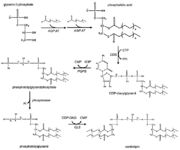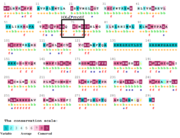User:Tereza Čalounová/Sandbox 1
From Proteopedia
| Line 61: | Line 61: | ||
== Disease - Barth syndrome== | == Disease - Barth syndrome== | ||
Barth syndrome (BTHS), also known as 3-Methylglutaconic aciduria type II, is an X-linked genetic disorder. The disease is caused by mutation in TAZ gene which encodes for protein tafazzin. <ref name="cit1">https://ghr.nlm.nih.gov/condition/barth-syndrome#</ref> Tafazzin works as an [https://en.wikipedia.org/wiki/Acyltransferase acyltransferase]in complex lipid metabolism, it is responsible for altering immature [https://en.wikipedia.org/wiki/Cardiolipin cardiolipin]- intermediate [https://en.wikipedia.org/wiki/Monolysocardiolipin monolysocardiolipin](with three linoleic acid side chains) (MLCL). <ref name="cit2">https://www.sciencedirect.com/science/article/pii/S092544391830334X?via%3Dihub</ref> <ref name="cit3">https://obgyn.onlinelibrary.wiley.com/doi/full/10.1002/pd.2599</ref> Cardiolipin makes up 20% of mitochondrial lipids and is closely connected with the electron transport chain proteins and the inner membrane structure of the mitochondria. <ref name="cit4">https://www.sciencedirect.com/topics/biochemistry-genetics-and-molecular-biology/tafazzin</ref> Mutations in TAZ gene lead to tafazzin not working properly, immature cardiolipin accumulates whereas the level of cardiolipin is low (mature cardiolopin has four linoleic acid side chains).<ref name="cit2" /><ref name="cit3" /> Mitochondria in affected patients are not having a normal shape and functions. Reduced energy production of mitochondria results in apoptosis of cells in tissues with high energy demands, especially cardiac and skeletal muscles. Moreover abnormally shaped mitochondria in white blood cells may affect their ability to proliferate. This causes [https://en.wikipedia.org/wiki/Neutropenia neutropenia]- decreased amount of white blood cells leading to higher risk of infections. <ref name="cit1" /> | Barth syndrome (BTHS), also known as 3-Methylglutaconic aciduria type II, is an X-linked genetic disorder. The disease is caused by mutation in TAZ gene which encodes for protein tafazzin. <ref name="cit1">https://ghr.nlm.nih.gov/condition/barth-syndrome#</ref> Tafazzin works as an [https://en.wikipedia.org/wiki/Acyltransferase acyltransferase]in complex lipid metabolism, it is responsible for altering immature [https://en.wikipedia.org/wiki/Cardiolipin cardiolipin]- intermediate [https://en.wikipedia.org/wiki/Monolysocardiolipin monolysocardiolipin](with three linoleic acid side chains) (MLCL). <ref name="cit2">https://www.sciencedirect.com/science/article/pii/S092544391830334X?via%3Dihub</ref> <ref name="cit3">https://obgyn.onlinelibrary.wiley.com/doi/full/10.1002/pd.2599</ref> Cardiolipin makes up 20% of mitochondrial lipids and is closely connected with the electron transport chain proteins and the inner membrane structure of the mitochondria. <ref name="cit4">https://www.sciencedirect.com/topics/biochemistry-genetics-and-molecular-biology/tafazzin</ref> Mutations in TAZ gene lead to tafazzin not working properly, immature cardiolipin accumulates whereas the level of cardiolipin is low (mature cardiolopin has four linoleic acid side chains).<ref name="cit2" /><ref name="cit3" /> Mitochondria in affected patients are not having a normal shape and functions. Reduced energy production of mitochondria results in apoptosis of cells in tissues with high energy demands, especially cardiac and skeletal muscles. Moreover abnormally shaped mitochondria in white blood cells may affect their ability to proliferate. This causes [https://en.wikipedia.org/wiki/Neutropenia neutropenia]- decreased amount of white blood cells leading to higher risk of infections. <ref name="cit1" /> | ||
| - | |||
| - | UPRAVIT: | ||
| - | This results in deficiency of cardiolipin (CL) with four linoleic acid side chains and relative excess of monolysocardiolipin (MLCL, with just three side chains), and hence to a highly abnormal MLCL/CL ratio (Valianpour et al., 2005; Schlame, 2007). This feature has recently allowed the development of a highly sensitive and specific assay applicable to lymphocytes, platelets, muscle biopsies, fibroblasts or even single stored neonatal bloodspots (Kulik et al., 2008). <ref name="cit3" /> | ||
=== Symptoms === | === Symptoms === | ||
Revision as of 20:19, 27 April 2019
This is our page where we will share informations about protein Tafazzin as a part of a school project with my classmates. This page is under a construction so please be aware of it. Zde přidám úvod
Tafazzin
| Theoretical Model: The protein structure described on this page was determined theoretically, and hence should be interpreted with caution. |
Tafazzin is a protein located in mitochondrial inner membranes. It is involved in altering cardiolipin. Cardiolipin is key in maintaining mitochondrial shape, energy production, and protein transport within cells. The full-length tafazzin protein contains 292 amino acids and has a molecular weight of 33459 daltons. Mutations in gene associated with this protein can cause Barth Syndrome. Barth syndrome (BTHS),is a genetic disorder diagnosed almost exclusively in males. BTHS is rare, it is estimated to affect 1 in 300,000 to 400,000 individuals worldwide. Males with BTHS have weak heart and skeletal muscles which can lead to heart failure. Another of the symptoms is neutropenia which can lead to infections. [1]
| |||||||||||
References
- ↑ https://ghr.nlm.nih.gov/condition/barth-syndrome#
- ↑ 2.0 2.1 https://www.uniprot.org/uniprot/Q16635?fbclid=IwAR3v10lUTRZfb0NFOYKC4wjaherdU9PIVJ8T63jkC9RfNu_5OQ2IpoDR0iY
- ↑ 3.0 3.1 3.2 3.3 http://www.lipidhome.co.uk/lipids/complex/dpg/index.htm
- ↑ 4.0 4.1 4.2 4.3 https://link.springer.com/article/10.1007%2Fs00018-008-8030-5
- ↑ https://commons.wikimedia.org/wiki/File:Cardiolipin_structure.svg?uselang=cs
- ↑ https://commons.wikimedia.org/wiki/File:Eukaryotic_pathway.jpg
- ↑ 7.0 7.1 7.2 https://www.ncbi.nlm.nih.gov/pmc/articles/PMC4342993/
- ↑ https://ghr.nlm.nih.gov/gene/TAZ#location
- ↑ 9.0 9.1 https://www.uniprot.org/uniprot/Q16635
- ↑ https://www.ncbi.nlm.nih.gov/pmc/articles/PMC4412953/
- ↑ 11.0 11.1 https://ghr.nlm.nih.gov/condition/barth-syndrome#
- ↑ 12.0 12.1 https://www.sciencedirect.com/science/article/pii/S092544391830334X?via%3Dihub
- ↑ 13.0 13.1 https://obgyn.onlinelibrary.wiley.com/doi/full/10.1002/pd.2599
- ↑ https://www.sciencedirect.com/topics/biochemistry-genetics-and-molecular-biology/tafazzin
- ↑ 15.0 15.1 15.2 15.3 https://www.ncbi.nlm.nih.gov/books/NBK247162/
- ↑ 16.0 16.1 https://swissmodel.expasy.org/repository/uniprot/Q16635
- ↑ http://pfam.xfam.org/protein/Q16635
- ↑ https://pfam.xfam.org/family/PF01553#tabview=tab4
- ↑ https://www.ncbi.nlm.nih.gov/pmc/articles/PMC107040/
- ↑ https://www.ncbi.nlm.nih.gov/pmc/articles/PMC4412953/



